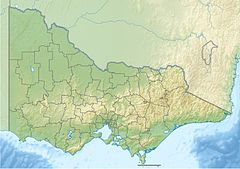Fiery Creek is a watercourse in western Victoria. It flows generally southerly from its source on the eastern side of Mount Cole in the Mount Cole State Forest to its mouth on the eastern side of Lake Bolac.
| Fiery Creek | |
|---|---|
| Location | |
| Country | Australia |
| State | Victoria |
| Local Government Areas | |
| Towns | |
| Physical characteristics | |
| Source | |
| • coordinates | 37°17′06″S 143°14′10″E / 37.285°S 143.236°E |
| • elevation | 760 metres (2,490 ft)[1] |
| Mouth | Lake Bolac |
• coordinates | 37°44′02″S 142°52′44″E / 37.734°S 142.879°E |
• elevation | 212 metres (696 ft)[2] |
| Basin features | |
| River system | Hopkins River |
| Tributaries | |
| • left |
|
| • right |
|
| Bridges | |
Geology
editFiery Creek begins in hills that contain granite and erode to produce granitic sand. Much of its course is across almost-flat farmland. Towards the end of its course, it reaches a former lava flow which interrupts the course and leads it west to Lake Bolac.[3]
Water use
editThe Central Highlands Region Water Corporation extracts up to 419 megalitres (92,000,000 imp gal) of water from the upper catchment to supply town water to the town of Beaufort. Stream flow at Streatham has been recorded for over 100 years. It has increasing periods of zero flow, but the record flow was over 24,000 megalitres per day (5.3×109 imp gal/d) in January 2011.[4]
Gold rush
editFiery Creek was involved in the Victorian gold rush in the 1850s. The diggings were in the upper reaches near Raglan. The post office that is now Streatham was named Fiery Creek, and mail was regularly addressed and sent to the wrong place.[5]
Gold was discovered near Beaufort in 1852, in tributaries of Fiery Creek, and north of Beaufort in Fiery Creek from 1854. The population on the fields was 50,000 in 1855[6] and reportedly reached approximately 100,000 people at its height in the late 1850s and produced 450,000 ounces of gold over a two-year period, 1855–1856.[7] The Fiery Creek gold rush started in 1854 and dissipated by 1859. Seven "puddling parties" remained by 1861. Dredging continued until around 1918.[8]
References
edit- ^ "Background". Friends of Mt Cole & the Pyrenees Ranges. Retrieved 30 May 2020.
- ^ "Map of Fiery Creek, VIC". Bonle Digital Atlas of Australia. Retrieved 30 May 2020.
- ^ "Fiery Creek (and its catchment)". Beyond Bolac. Retrieved 30 May 2020.
- ^ "Fiery Creek flows". Beyond Bolac. Retrieved 30 May 2020.
- ^ "DOMESTIC INTELLIGENCE". The Argus (Melbourne). Victoria, Australia. 13 November 1855. p. 5. Retrieved 31 May 2020 – via Trove.
- ^ "Colonial News". The Maitland Mercury and Hunter River General Advertiser. New South Wales, Australia. 3 November 1855. p. 3 (Supplement to the Maitland Mercury). Retrieved 3 June 2020 – via Trove.
- ^ "History". Pyrenees Tourism. Pyrenees Shire. 2006. Archived from the original on 21 February 2006. Retrieved 10 July 2006.
- ^ Ballinger, Robyn; Westbrooke, Samantha (March 2016). "Ararate Rural City Thematic Environmental History" (PDF). Rural Ararat Heritage Study. Ararat Rural City. pp. 43, 46. Retrieved 3 June 2020.
External links
edit- McKinnis, David (February 2007). "Fiery Creek Walk Diary". The Healing Walk. Retrieved 30 May 2020.
